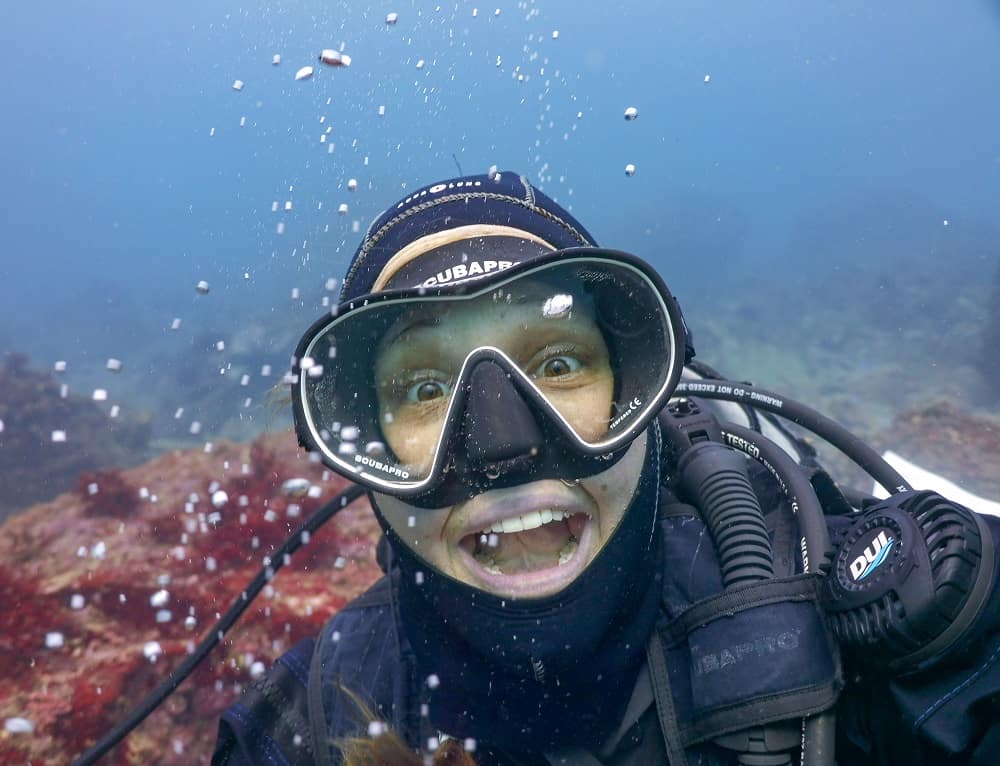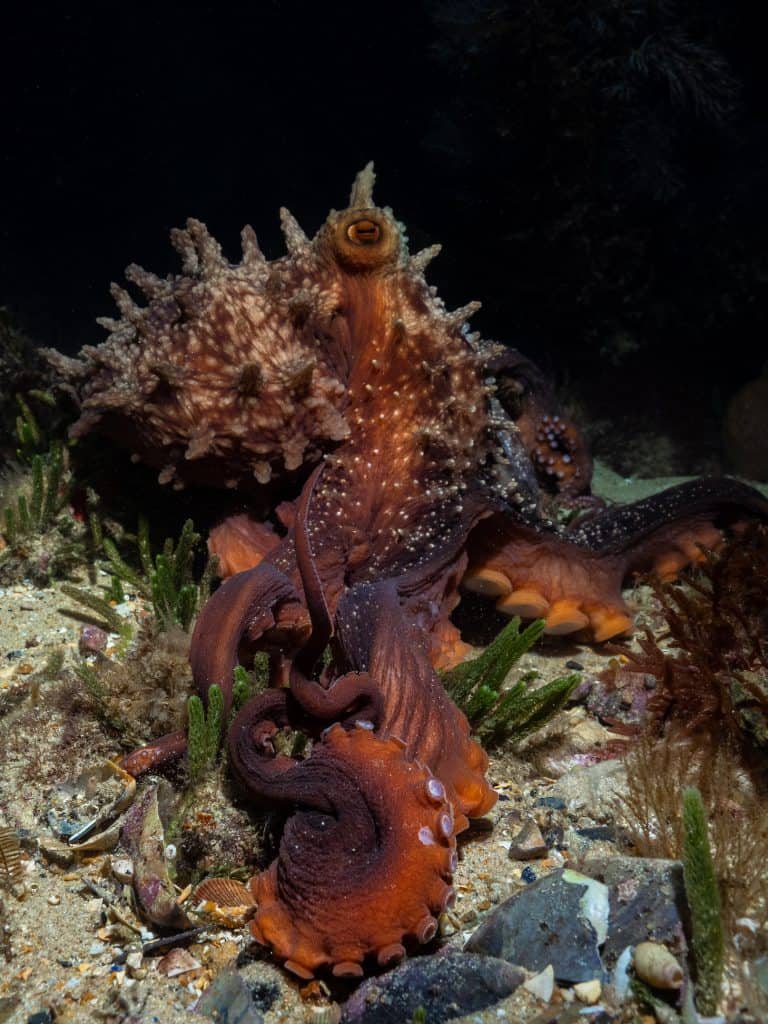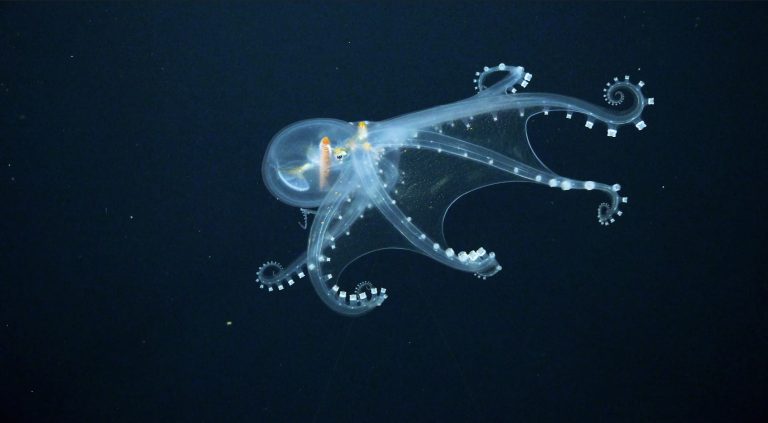Maori Octopus Facts: One Of New Zealand’s Largest Species!
Dark red with smooth speckled white skin and long uneven arms…who am I? The Maori Octopus, of course! One of the largest and strongest octopus species found around New Zealand and Australia with the power to suffocate a dolphin! Read on to learn more Maori Octopus facts and everything there is to know about this amazing southern hemisphere ocean dweller.
The Maori Octopus (Macroctopus Maorum) is a real beefcake of the octopus world with long muscular arms of varying lengths, the front pair being the longest and broadest (up to 9.8 feet/3 meters).
It lives in shallow subtidal areas where it has its pick of what’s for dinner. The Maori Octopus would rather hunt around, opting for a nice juicy crustacean, scallop, or particular fish instead of eating the first thing that’s available.
You can usually recognize this octopuses rock lair by the scattered remains of crabs and mussel shells out front. A favorite snack of theirs is rock lobster, with fishermen often finding the Maori Octopus caught in their lobster pots.

7 Fun Facts About The Maori Octopus!
With so many of you asking us questions about the Maori Octopus on our Facebook and Instagram posts, we wanted to share some more fun facts about this gigantic octopus.
They WILL eat each other.
Cannibalism is a common behavior for many species of octopus in the order of large eating small— however, even small robust Maori Octopuses are known to attack and overpower larger octopus species if their habitats overlap.

🐙 Octopus Fun Fact
Marine Biologists believe that octopus cannibalism is driven by energy efficiency. Why spend time and effort biting and prying open a mussel when octopus meat is higher per gram in protein! Just common octopus sense right there.
However, male Maori Octopuses have learned this the hard way. When a female isn’t in the mood to mate, their failed attempts lead to them being dinner!

Have you heard of a dolphin named Gilligan?
The next B-rated movie coming to a streaming service near you: Octo vs. Dolphin!
In 2012, an Indo-Pacific bottlenose dolphin, known as Gilligan to researchers in Australia, met its untimely demise when it attempted to snack on a Maori Octopus. The dolphin washed up on the beach with octopus arms hanging out of the side of its mouth.
🐙 Octopus Fun Fact
An autopsy of the dolphin found 7 (yes-SEVEN!) arms in the back of its throat with suckers gripping onto the walls, which eventually lead to the suffocation.
Talk about not going down without a fight!
Honestly, there don’t seem to be any real winners in this particular octopus vs. dolphin match.
The Maori Octopus shed skin on their suckers to improve their taste buds!
Out of all the Maori Octopus facts, this one has to be the coolest!
Just like our nails grow, and we groom them, the outer layer of skin on a Maori Octopus’s suckers grows and sheds.
We know octopuses use their suckers to:
- Taste
- Smell
- Grip onto prey items
- And, feel their way around a reef so they must be kept in tip top condition.

🐙 Octopus Fun Fact
To keep their suckers at peak sensory levels, the Maori Octopus swirls or rubs their suckers over their bodies helping to slowly peel away old skin. With their chemoreceptors fresh, when they do get ahold of a delicious rock lobster, they are sure to fully enjoy it!
They use WHAT to propel themselves?
An octopus’s siphon (also called a funnel) is a multi-purpose muscular appendage with all sorts of wondrous uses. It is located on the side of the mantle cavity and most importantly is how an octopus breathes!
When the Maori Octopus inhales, it uses its siphon to bring water into their mantle cavity where they flush water over their gills, extracting the oxygen, and then exhale the water out. Not only does it breathe through that opening, but it also:
- Disperses ink
- Shoots poop that looks like silly string
- Exhales jets of water to propel its body forward!
It is also an excellent digging tool, which they use to jet out water to puff away the sand.

🐙 Octopus Fun Fact
Blasting animals with high-speed water is another option an octopus has with its siphon when they are feeling anti-social.
Okay, I take it back. Out of all the Maori Octopus facts, THIS has to be the coolest. (I clearly can’t choose. They are all fascinating!)
You can tell how old they are by the remnants of their shell.
Octopuses are part of the mollusk group and millions of years ago, they used to have shells! Obviously, they lost them to become the squishy wonders that they are today; however, the remnants of that long-forgotten shell remain. It is called a stylet!
Not all octopus species have them, but the Maori Octopus has two stylets that serve as supports for muscles in their head. They are made of chitin which is the same thing that a beetle’s outsides are made of.
🐙 Octopus Fun Fact
How does this rigid structure tell us their age? Stylets have growth lines just like rings on a tree! Sadly, the octopus has to be dead for someone to examine their stylets; so this age-telling structure is only accessible once an octopus has passed away.

Mama octopuses = The ultimate warrior
The female Maori Octopus lay their ~7000 eggs over a two week period in rock crevices, cementing them to the hard surface, and then camp out with them till they hatch. Imagine a camping trip with your kids where no one leaves until they are grown. Yikes!
The Maori Octo Mama tends to her eggs for just 2 months but, during that time, she doesn’t eat any food! All her focus is on her eggs, making sure they are protected from hungry predators, free of parasites, and sufficiently oxygenated.
Like most octopuses, the Maori female dies shortly after her babies hatch.
Octopus are the traditional health model for the Maori people!
In Maori, wheke means octopus. The concept of Te Wheke defines a family’s health.
- The head and body of the octopus represent te whanau, meaning family.
- The eyes represent waiora which is meant to reflect the total wellbeing of the family and individual.
- An octopus’s arms symbolize different dimensions of health, such as spirituality, physical wellbeing, extended family and the life force in people and objects just to name a few.
These arms of a family’s health are interwoven with one another focusing not only on a person’s physical wellbeing but also their mental health, including relationships with other family members, others, and the natural world.
The Maori Octopus: One Of New Zealand’s Largest!
Did you enjoy learning more Maori Octopus facts? Check out their Octopedia species profile here to learn even more!
If you want to educate yourself some more about all sorts of different cephalopods, take a look at our encyclopedia. Or, what we call it, our Octopedia!
Connect with other octopus lovers via the OctoNation Facebook group, OctopusFanClub.com! Make sure to follow us on Facebook and Instagram to keep up to date with the conservation, education, and ongoing research of cephalopods.
More Posts To Read:
If you enjoyed learning about The Maori Octopus, we recommend taking a look at some of these other profiles:
- 5 Awesome Dumbo Octopus Facts (The Cutest Octopus Ever!)
- 7 Fun Facts About The Majestic Mimic Octopus!
- Tiny Hairy Octopus: The Cutest Species You’ve NEVER Heard Of!
- 9 Giant Pacific Octopus Facts That Will Blow Your Mind
- Fun Facts About The Female Blanket Octopus (Superhero Of The Sea)

Corinne is a biologist with 10 years of experience in the fields of marine and wildlife biology. She has a Master’s degree in marine science from the University of Auckland and throughout her career has worked on multiple international marine conservation projects as an environmental consultant. She is an avid scuba diver, underwater photographer, and loves to share random facts about sea creatures with anyone who will listen. Based in Japan, Corinne currently works in medical research and scientific freelance writing!









